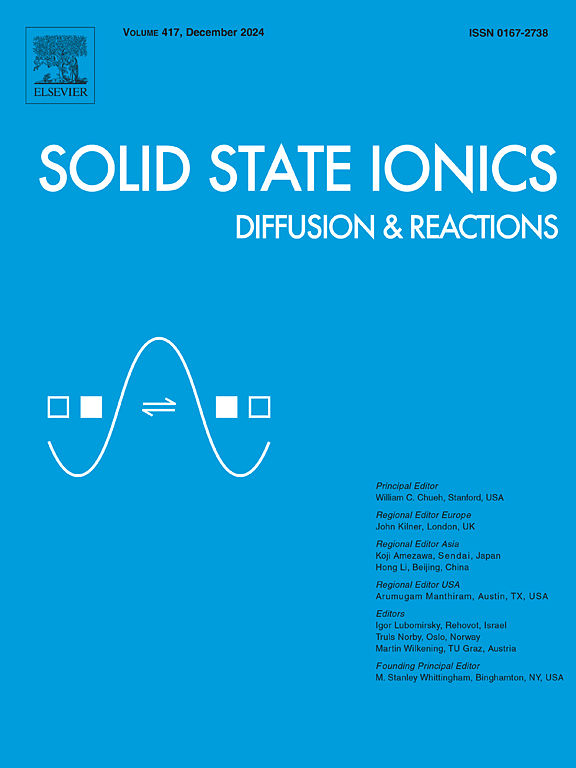磺化聚偏氟乙烯/氧化石墨烯与热机械改性粉煤灰组成的功能化纳米复合膜在pemfc中的应用
IF 3
4区 材料科学
Q3 CHEMISTRY, PHYSICAL
引用次数: 0
摘要
聚合物电解质膜燃料电池(PEMFCs)以其高效、零排放等优点成为一种极具发展前景的技术。目前的工作是制造一种具有成本效益的纳米复合质子交换膜(PEM),该膜是通过在实验室中通过改进的悍马方法制备的氧化石墨烯(GO)和在宿主PVDF[聚偏氟乙烯]聚合物基体中加入热机械改性的粉煤灰(FA)来制备的。随后,用磺化剂氯磺酸在60°C下处理纳米复合膜30分钟。使用各种光谱方法,包括XRD, FTIR,激光拉曼,FESEM-EDX和AFM分析,验证了氧化石墨烯和FA纳米颗粒进入聚合物基体和膜磺化。制备的SPGF-3膜的最高离子交换容量(IEC)和质子电导率(PC)分别为0.88 meq g−1和4.08 × 10−2 S/cm。此外,有趣的是,当温度从25°C增加到75°C时,制备的膜(SPGF-3)的吸水能力分别从25.6%提高到30.6%。燃料电池性能测试表明,磺化膜由95%的PVDF、2.5%的GO和2.5%的FA组成,最大电流密度为1000 mA cm - 2,功率密度为448 mW cm - 2,这表明它有潜力替代昂贵的Nafion膜用于pemfc应用。本文章由计算机程序翻译,如有差异,请以英文原文为准。
Development of functionalized nanocomposite membrane composed of sulfonated PVDF/GO and thermo-mechanically modified Fly-Ash for application in PEMFCs
Polymer electrolyte membrane fuel cells (PEMFCs) have become a promising technology due to their high efficiency and zero emission of toxic gases. The present work deals with the fabrication of a cost-efficient nanocomposite proton exchange membrane (PEM), prepared by incorporation of graphene oxide (GO) prepared in the laboratory by modified Hummer's method and thermo-mechanically modified Fly Ash (FA) within the host PVDF [poly(vinylidene fluoride)] polymer matrix. Subsequently, the nanocomposite membranes were treated with the well-known sulfonating agent chlorosulfonic acid at 60 °C for 30 min. The incorporation of GO and FA nanoparticles into the polymer matrix and the membrane sulfonation was verified using various spectroscopic methods, including XRD, FTIR, Laser Raman, FESEM-EDX, and AFM analyses. The highest ion exchange capacity (IEC) and proton conductivity (PC) are observed to be 0.88 meq g−1 and 4.08 × 10−2 S/cm respectively for the fabricated membrane SPGF-3. Further, it was interesting to note that with an increase in temperature from 25 °C to 75 °C, the fabricated membrane (SPGF-3) exhibited enhanced water uptake capacity from 25.6 % to 30.6 % respectively. The fuel cell performance test showed that the sulfonated membrane, composed of 95 wt% PVDF, 2.5 wt% GO, and 2.5 wt% FA, achieved a maximum current density of 1000 mA cm−2 and a power density of 448 mW cm−2 which quantifies its potency towards an alternative to costly Nafion membranes for PEMFCs application.
求助全文
通过发布文献求助,成功后即可免费获取论文全文。
去求助
来源期刊

Solid State Ionics
物理-物理:凝聚态物理
CiteScore
6.10
自引率
3.10%
发文量
152
审稿时长
58 days
期刊介绍:
This interdisciplinary journal is devoted to the physics, chemistry and materials science of diffusion, mass transport, and reactivity of solids. The major part of each issue is devoted to articles on:
(i) physics and chemistry of defects in solids;
(ii) reactions in and on solids, e.g. intercalation, corrosion, oxidation, sintering;
(iii) ion transport measurements, mechanisms and theory;
(iv) solid state electrochemistry;
(v) ionically-electronically mixed conducting solids.
Related technological applications are also included, provided their characteristics are interpreted in terms of the basic solid state properties.
Review papers and relevant symposium proceedings are welcome.
 求助内容:
求助内容: 应助结果提醒方式:
应助结果提醒方式:


